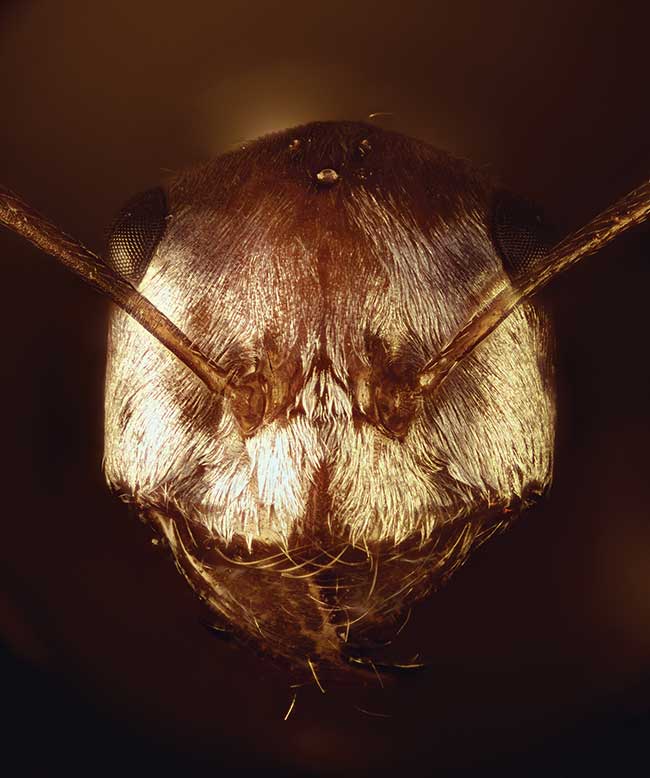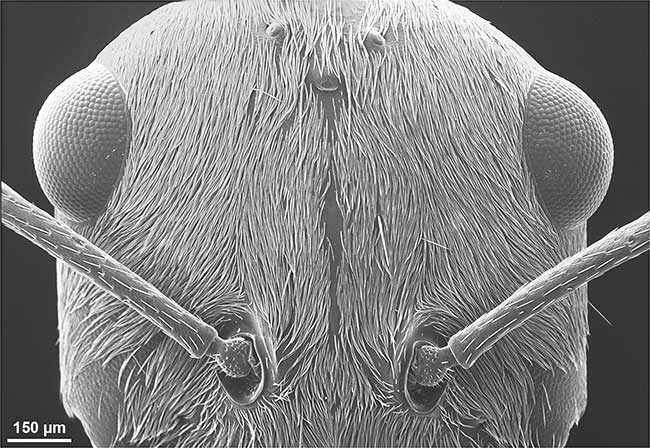
Ants Give Roofs Good Optics
With winter around the corner, many homeowners are rushing to have a new roof installed before the snow starts falling. Some people may gripe about the cost, others may question whether they should have gone with the higher-end materials, but it would be hard to find any who wished their roofs could benefit from ants.
Nanfang Yu, an assistant professor of applied physics at Columbia University’s School of Engineering and Applied Science, is an exception to the last category. And not just any ants — Saharan silver ants (Cataglyphis bombycina), such as those found in Tunisia. Yu and several other researchers discovered these ants can forage through their namesake desert at the hottest time of day — when surface temperatures are between 60 and 70 ºC (140 and 158 ºF) — by combining enhanced optical reflection and radiative heat dissipation.

Head of a Saharan silver ant. Courtesy of Nanfang Yu and Norman Nan Shi.
In addition to giving the ants their silvery appearance, a dense array of triangular-shaped hairs helps the insects stay cool. These uniquely shaped hairs lower the ants’ body temperature by enhancing the reflection of solar radiation in the visible and near infrared (NIR) range. The hairs also outwardly radiate heat through enhanced mid-infrared (MIR) emissivity.
“Saharan silver ants are almost unique as they choose to forage at the hottest moment of the day in order to avoid predatory lizards and to find maximal amount of dead insects, so it makes sense that they develop an extra strategy, the silvery coating, to manage thermoregulation,” said Yu.
With the help of a scanning electron microscope, the researchers were the first to show how the ants’ hairs control electromagnetic waves from the visible to MIR ranges. In a paper published in Science in July 2015, the researchers described the hairs’ triangular cross section as being characterized by “two corrugated top facets and a flat bottom facet facing the ant’s body.” Focused ion beam milling provided cross-sectional views, which revealed “the gap between the bottom hair facet and the cuticular surface also varies but is generally larger than a few hundred nanometers.”

Scanning electron microscope image of a Saharan silver ant head. Courtesy of Rainer F. Foelix.
Also participating in this study were researchers from the University of Seattle’s Department of Electrical Engineering, and the University of Zurich’s Brain Research Institute in Switzerland. Yu’s lab is now working on developing a Saharan-silver-ant-inspired cool-roof coating.
“The materials and geometries of the cool-roof coating are chosen to maximize the reflection of the sunlight and in the meantime maximize the emissivity in the thermal radiation spectrum. These two properties combined will lead to optimal passive cooling of a building without consuming any electricity and to maximum offset of air-conditioning bills,” he said.
Such enhanced optical reflection is not exclusive to the Saharan silver ant. Yu noted that small moths, such as clothing moths (Tineola bisselliella) have light coloration, affording them good visible light and high NIR reflectivity. This guards them against desiccation, or extreme drying, due to sun exposure.
Moths’ contributions to roofing, however, will likely be limited to their infestation of roof spaces and roof insulation.
Published: September 2016